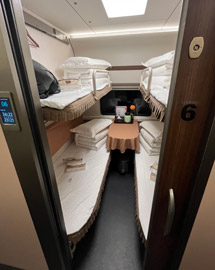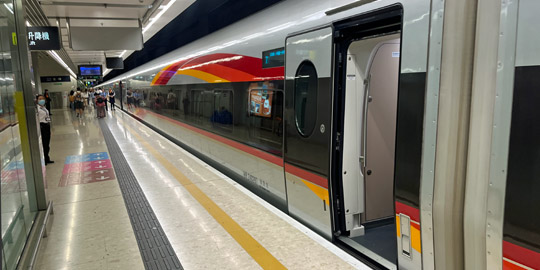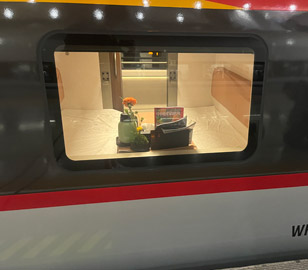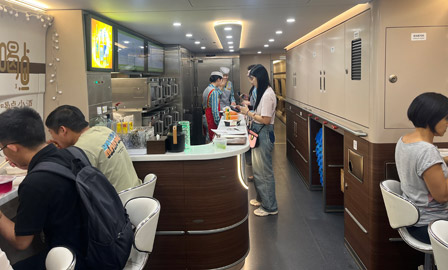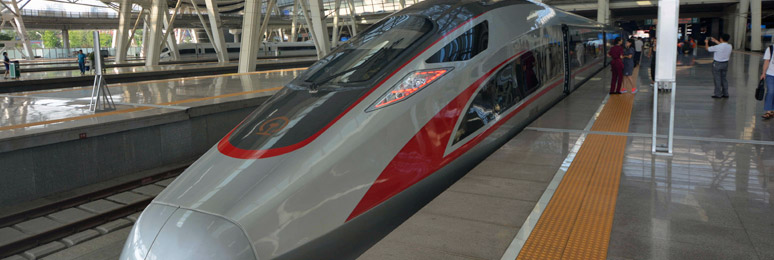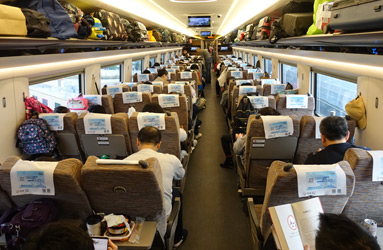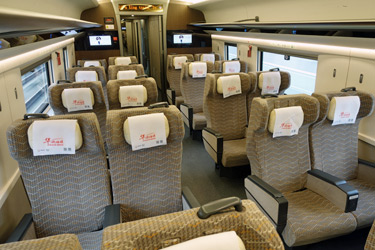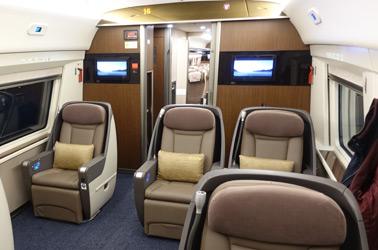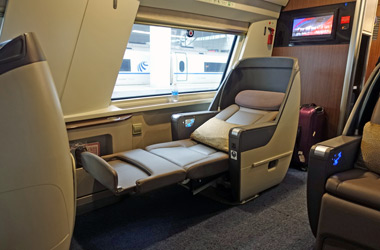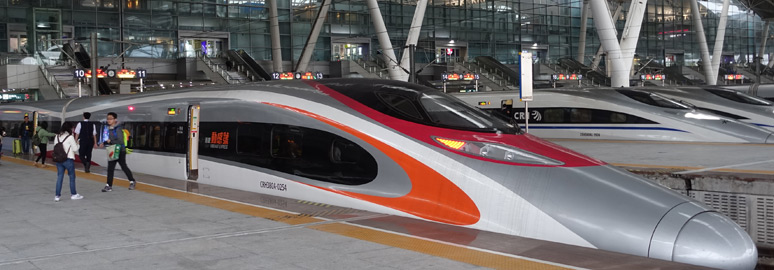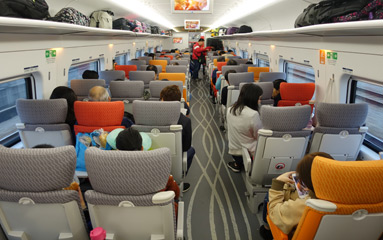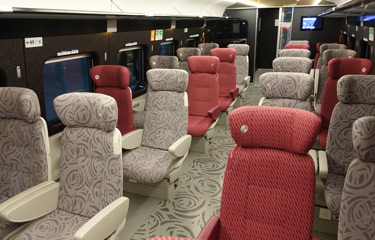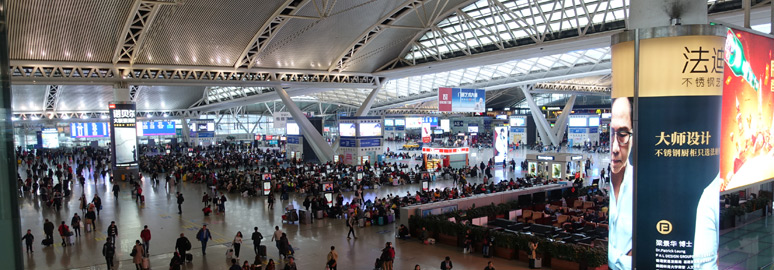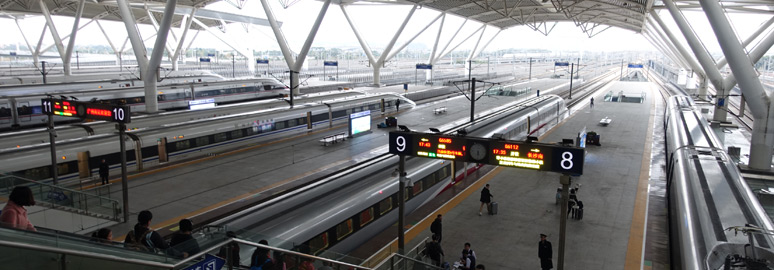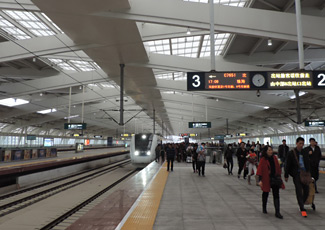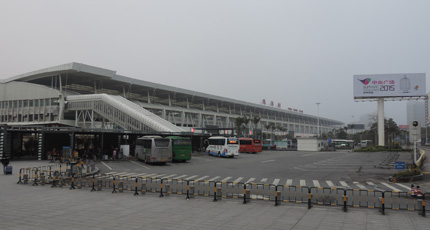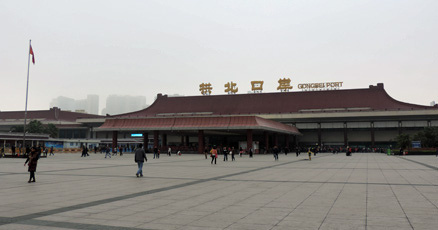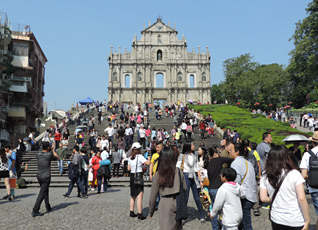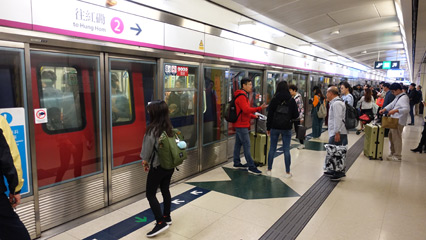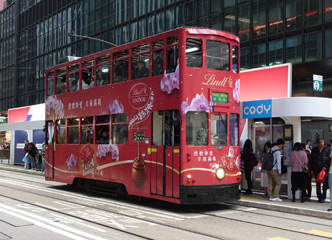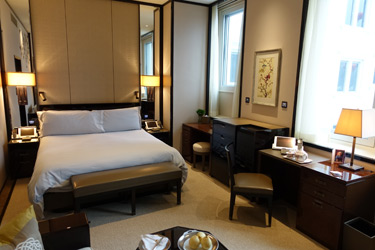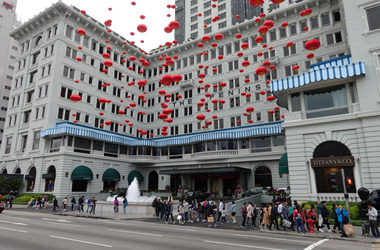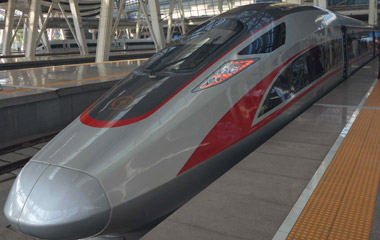 |
|
|
A CRH400 high-speed train, capable of 350km/h on journeys between Hong Kong, Beijing & Shanghai. Buy tickets online at www.chinahighlights.com. How to buy Chinese train tickets, full details. |
Hong Kong by train
Once a British colony, now a special administrative region of China, Hong Kong has its own border controls & immigration policies, and its own currency. It's easy to reach by train from Beijing, Shanghai, Guangzhou or any other Chinese city. Indeed, until the war in Ukraine it was possible to travel between Hong Kong and Europe by Trans-Siberian Railway (I know, I've done it). This page explains how to travel between Hong Kong and major cities in China and beyond, in either direction.
- Option 1, by high-speed train
- Option 2, by high-speed sleeper train
![]() Hong Kong - Guilin, Nanning,
Kunming & other cities
Hong Kong - Guilin, Nanning,
Kunming & other cities
![]() Hong Kong - Bangkok,
Kuala Lumpur, Singapore
Hong Kong - Bangkok,
Kuala Lumpur, Singapore
![]() Hong Kong - Tokyo & Japan by train & ferry
Hong Kong - Tokyo & Japan by train & ferry
![]() Hong Kong - Europe by
Trans-Siberian Railway
Hong Kong - Europe by
Trans-Siberian Railway
![]() Travel insurance, Curve card & VPN
Travel insurance, Curve card & VPN
Useful country information
Hong Kong to Beijing
There are two good options for travel between Beijing & Hong Kong, in either direction.
-
Option 1, by high-speed train in 8h56. The Guangzhou-Kowloon high-speed rail link opened on 23 September 2018 and a high-speed Fuxing (revival) train links Hong Kong West Kowloon Station with Beijing West every day, 1,516 miles in 8h56 at an incredible average speed of 168 mph.
-
Option 2, by high-speed sleeper train. This is the time-effective option! Sleep your way between Hong Kong & Beijing in just one night, saving a hotel bill too. The new direct high-speed sleeper trains start 15 June 2024, they run on Friday, Saturday, Sunday & Monday nights.
Which option to choose? With the high-speed day train (option 1) you get to experience China's impressive and expanding high-speed rail network. However, it's more expensive than the other options and if time is important. the high-speed sleeper train (option 2) is more time-effective as you leave in the evening, arrive in the morning and it saves a hotel bill. In fact, it's more time-effective (and a lot more fun) than a morning of airports & delayed flights.
Option 1, by high-speed train
Hong Kong to Beijing in a single day! Since the opening of the Hong Kong high-speed rail link on 23 September 2018, it's been possible to travel between Beijing and Hong Kong in a single day on a direct 300 km/h (186 mph) bullet train. You get to travel across China on one of it's impressive new high-speed railways while you admire the scenery, catch up on your reading and enjoy a beer or two from the bar car.
See the Hong Kong to Beijing page for timetable, fares & how to buy tickets.
Option 2, by high-speed sleeper train
This is the most time-effective option, a fun experience which also saves a hotel bill. A Shenzhen-Beijing D-category sleeper train was extended to start in Hong Kong on Friday to Monday nights starting in June 2024. In October 2024 it was upgraded to a G-category train with faster timings. It's the ideal way to travel between HK and Beijing!
Hong Kong ► Beijing
-
Sleeper train G898 leaves Hong Kong West Kowloon at 20:25 on Friday, Saturday, Sunday & Monday nights, arriving Beijing Xi (West) 06:53.
In October 2024 the train was upgraded to a G-category Fuxing high-speed sleeper train with 16 cars, capable of 350 km/h:
Cars 1 & 16 each have 45 2nd class seats and 12 1st class seats. 2nd class seats are arranged 2+3 across the car width, 1st class 2+2.
Cars 2-15 are soft sleeper cars. These each have ten 4-berth soft sleeper compartments, except for car 8 which has 4 soft sleeper compartments, a 2-berth wheelchair-accessible sleeper compartment and a cafe-bar. All sleeper berths come with an individual berth light, power outlet, pillow and bedding.
Beijing ► Hong Kong
-
Sleeper train G897 leaves Beijing Xi (West) at 20:13 Friday, Saturday, Sunday & Monday nights, arriving Hong Kong West Kowloon 07:12.
This is a G-category Fuxing high-speed sleeper train with 16 cars, capable of 350 km/h:
Cars 1 & 16 each have 45 2nd class seats and 12 1st class seats. 2nd class seats are arranged 2+3 across the car width, 1st class 2+2.
Cars 2-15 are soft sleeper cars. These each have ten 4-berth soft sleeper compartments, except for car 8 which has 4 soft sleeper compartments, a 2-berth wheelchair-accessible sleeper compartment and a cafe-bar. All sleeper berths come with an individual berth light, power outlet, pillow and bedding.
How much does it cost?
The fare is $280 in a soft sleeper, $191 in a 1st class seat or $141 in a 2nd class seat.
How to buy tickets
Option 1, buy tickets at www.chinahighlights.com, a reliable agency that I can recommend. They can book all classes, and offer basic seat selection on D & G category high-speed trains, allowing you to request aisle or window seats or two seats side-by-side.
Travel is ticketless, you scan your passport at the automatic gates at the entrance to the platform, the system recognises your passport number, knows you have a reservation and lets you through, see more about finding & boarding your train.
Option 2, buy tickets at www.trip.com, another well-known and reliable agency, travel is also ticketless.
What's the sleeper train like?
The train is a G-category Fuxing high-speed train with 16 cars, capable of 350 km/h: Cars 2-15 have 4-berth soft sleeper compartments, cars 1 & 16 each have 45 2nd class seats and 12 1st class seats. 2nd class seats are arranged 2+3 across the car width, 1st class 2+2.
G-category sleeper train with 4-berth soft sleepers. Photos courtesy of Tom Peart.
Above right, cafe-bar on the G-category sleeper train. Photos courtesy of Josep Perna.
Hong Kong to Shanghai
Since the opening of Hong Kong's new high-speed rail link on 23 September 2018, it's been possible to travel between Hong Kong & Shanghai in a single day. You get to travel across China on one of its impressive new high-speed railways while you admire the scenery, catch up on your reading and enjoy a beer or two in the bar car. And from June 2024 there's a high-speed sleeper train too, on Friday, Saturday, Sunday & Monday nights.
Luggage allowance
You take your bags with you onto the train, and put them on the racks near your seat. Bags may be X-rayed before entering the station. The luggage limit on Chinese trains is 20 Kg for adults & 10 Kg for children, and the maximum dimension of any item should not exceed 130cm on G-category trains like these. However, in practice no-one weighs or measures your bags, as long as they comfortably fit through the security X-ray machines and you can carry them onto the train, you'll be fine. If you really want to transport vast quantities of luggage you can pay for a baggage ticket for bags in excess of the official limits.
Which station in Hong Kong?
The station for high-speed trains is Hong Kong West Kowloon, the high-speed train terminal opened in 2018. See map of Hong Kong showing station location. You should arrive at least 45 minutes before the train leaves to complete Hong Kong & mainland China border formalities.
Border formalities when leaving Hong Kong for Shanghai
Hong Kong & Chinese border formalities take place at Hong Kong West Kowloon station before you board the train. I would arrive at the station at least 60 minutes before your train. I found we were through formalities and waiting in the departure lounge a mere 15 minutes after entering the station, but it will take longer at busy times! On arrival in Beijing there are no further formalities, you just walk out of the station. See the Hong Kong to Beijing page for a description of the check-in process at Hong Kong with photos, it's the same process whether you're going to Beijing or Shanghai.
Border formalities when travelling from Shanghai to Hong Kong
There are no formalities to go through before boarding the train in Shanghai, other than the usual ticket check and X-ray baggage scan which you should expect when entering any Chinese station, whether mainline or metro. Don't cut it fine, but turning up 20-30 minutes before your train is sufficient. Hong Kong & Chinese border formalities take place at Hong Kong West Kowloon station after the train arrives. You take the lifts or escalators from the platform on Level B4 up to Level B2 where you go through mainland China passport control, mainland China customs (another X-ray bag check!) and then Hong Kong passport control. It took me just 25 minutes to pass through Chinese exit & Hong Kong entry formalities from the time my train arrived to the time I walked out of Hong Kong West Kowloon station into Austin MTR metro station, although at very busy times it could take up to an hour.
How much does it cost?
|
Sleeper train |
2nd class |
Soft sleeper |
Deluxe sleeper |
|
Shanghai - Hong Kong |
$101 |
$176 |
? |
How to buy tickets
Option 1, buy tickets at www.chinahighlights.com, a reliable agency that I can recommend.
They can book all classes, and offer basic seat selection on D & G category high-speed trains, allowing you to request aisle or window seats or two seats side-by-side.
Travel is ticketless, you scan your passport at the automatic gates at the entrance to the platform, the system recognises your passport number, knows you have a reservation and lets you through, see more about finding & boarding your train.
Option 2, buy tickets at www.trip.com, another well-known and reliable agency, travel is also ticketless.
Deluxe soft sleepers are in short supply, may not be available on every departure (possibly only Sat & Mon from Hong Kong, Fri & Sun from Shanghai) and some vendors don't show them.
What is the day train like?
The G99 and G100 between Hong Kong & Shanghai are operated by 16-car CR400AF Fuxing (revival) high-speed trains. These are the world's fastest passenger trains, designed for up to 400 km/h and operating in service at up to 350 km/h (217 mph), although you're unlikely to exceed 300 km/h (186 mph) on the Hong Kong to Shanghai route. The train has 2nd class, 1st class & business class plus a small cafe counter selling Chinese tea, coffee, beer, snacks & microwaved hot dishes. Unlike some other Chinese high-speed trains there are no sit-down cafe tables, just the serving counter.
Above, a G-category high-speed train of the CRH400AF Fuxing type, as usually used on the G79 & G100 between Hong Kong & Shanghai. Courtesy of Brett Cubit.
Business class seats are arranged 2+1 across the car width, except for the pair of seats immediately behind the driving cab at each end of the train where the train body tapers, where seats are 1+1 across the car width. On this 16-car CR400AF-A train, the whole of car 1 is business class, and there's also a small 5-seat business class area at other end of the train in car 16, seen here. The seats recline electrically and become a flat bed at the touch of a button, a blanket & cushion are supplied. Each seat has a power socket. The fare includes one hot tray meal (pictured below right) and a steady stream of Chinese tea, coffee, apple juice, orange juice or soft drinks. You'll also get a complimentary box of strange Chinese biscuits & sweets. There's a VIP lounge for business class passengers at Shanghai Hongqiao & Hong Kong West Kowloon. Business class is expensive even by western standards, but if you can stretch that far it's well worth it. Click the images for larger photos.
What is the sleeper like?
From 1 October 2024 this train is upgraded to a G-category Fuxing high-speed train with 16 cars, capable of 350 km/h: Cars 1 & 16 each have 45 2nd class seats and 12 1st class seats. 2nd class seats are arranged 2+3 across the car width, 1st class 2+2. Cars 2-15 are soft sleeper cars. These each have ten 4-berth soft sleeper compartments, except for car 8 which has 4 soft sleeper compartments, a 2-berth wheelchair-accessible sleeper compartment and a cafe-bar. All sleeper berths come with an individual berth light, power outlet, pillow and bedding.
G-category sleeper train with 4-berth soft sleepers. Photos courtesy of Tom Peart.
Above right, cafe-bar on the G-category sleeper train. Photos courtesy of Josep Perna.
Hong Kong to Xian
Starting 5 January 2025, a direct G-category high-speed train links Hong Kong with Xian every day, with 2nd class, 1st class and business class.
Luggage allowance
You take your bags with you onto the train, and put them on the racks near your seat. Bags may be X-rayed before entering the station. The luggage limit on Chinese trains is 20 Kg for adults & 10 Kg for children, and the maximum dimension of any item should not exceed 130cm on G-category trains like these. However, in practice no-one weighs or measures your bags, as long as they comfortably fit through the security X-ray machines and you can carry them onto the train, you'll be fine. If you really want to transport vast quantities of luggage you can pay for a baggage ticket for bags in excess of the official limits.
Which station in Hong Kong?
The station for high-speed trains is Hong Kong West Kowloon, the high-speed train terminal opened in 2018. See map of Hong Kong showing station location. You should arrive at least 45 minutes before the train leaves to complete Hong Kong & mainland China border formalities.
In Xian, Xianbei (Xian North Station) is 10 km (6 miles) north of the city centre and the original Xian station, see location map.
Border formalities when leaving Hong Kong for Xian
Hong Kong & Chinese border formalities take place at Hong Kong West Kowloon station before you board the train. I would arrive at the station at least 60 minutes before your train. I found we were through formalities and waiting in the departure lounge a mere 15 minutes after entering the station, but it will take longer at busy times! On arrival in Beijing there are no further formalities, you just walk out of the station. See the Hong Kong to Beijing page for a description of the check-in process at Hong Kong with photos, it's the same process whether you're going to Beijing or Shanghai.
Border formalities when travelling from Xian to Hong Kong
There are no formalities to go through before boarding the train in Xian, other than the usual ticket check and X-ray baggage scan which you should expect when entering any Chinese station, whether mainline or metro. Don't cut it fine, but turning up 20-30 minutes before your train is sufficient. Hong Kong & Chinese border formalities take place at Hong Kong West Kowloon station after the train arrives. You take the lifts or escalators from the platform on Level B4 up to Level B2 where you go through mainland China passport control, mainland China customs (another X-ray bag check!) and then Hong Kong passport control. It took me just 25 minutes to pass through Chinese exit & Hong Kong entry formalities from the time my train arrived to the time I walked out of Hong Kong West Kowloon station into Austin MTR metro station, although at very busy times it could take up to an hour.
How much does it cost?
How to buy tickets
Option 1, buy tickets at www.chinahighlights.com, a reliable agency that I can recommend. They can book all classes, and offer basic seat selection on D & G category high-speed trains, allowing you to request aisle or window seats or two seats side-by-side.
Travel is ticketless, you scan your passport at the automatic gates at the entrance to the platform, the system recognises your passport number, knows you have a reservation and lets you through, see more about finding & boarding your train.
Option 2, buy tickets at www.trip.com, another well-known and reliable agency, travel is also ticketless.
Hong Kong to Guangzhou
For a brief period between 2018 and 2019, there were two train services between Hong Kong and the nearest big Chinese city, Guangzhou, formerly known as Canton. The classic Kowloon-Canton Railway with its Intercity through trains had been running for a century before it ceased running in 2019 due to the pandemic, and it has not resumed. The new high-speed link opened in 2018, half of it in tunnel, and this is now the only train link between these cities.
By high-speed train
Hong Kong's high-speed rail link opened on 23 September 2018, and high-speed trains now link Hong Kong West Kowloon station with Guangzhou South (Guangzhounan) in as little as 47 minutes with 1, 2 or even 3 departures every hour. See map of Hong Kong showing station.
Most departures are operated by Chinese Railways Fuxing (revival) high-speed trains with 2nd class, 1st class & business class, see photos of each class on a Fuxing high-speed train here & watch the video here.
However, several departures per day between Hong Kong & Guangzhou South are operated by Vibrant Express trains owned by MTR (the Hong Kong mass transit corporation), see the photos below and see this video showing a new Vibrant train inside & out. Vibrant Express trains have 1st & 2nd class, but no business class.
See the route map here - the new high-speed line is shown in red. From Hong Kong West Kowloon to the Chinese border the line runs entirely in tunnel with trains limited to 200 km/h (125 mph). The line emerges into daylight near the border and calls at Shenzhen North (Shenzhenbei) before running above ground to Guangzhou South at up to 300 km/h (186 mph).
Luggage allowance
You take your bags with you onto the train, and put them on the racks in your sleeper compartment. Bags may be X-rayed before entering the station. The luggage limit on Chinese trains is 20 Kg for adults & 10 Kg for children, and the maximum dimension of any item should not exceed 130cm on G-category high-speed trains. However, in practice no-one weighs or measures your bags, as long as they comfortably fit through the security X-ray machines and you can carry them onto the train, you'll be fine. If you really want to transport vast quantities of luggage you can pay for a baggage ticket for bags in excess of the official limits.
Border formalities when leaving Hong Kong for Guangzhou
All border formalities take place at Hong Kong West Kowloon station before you board the train. You should arrive at the station at least 45 minutes before your train, although I found we were through formalities and waiting in the departure lounge a mere 15 minutes after entering the station. It might take longer at busy times! On arrival in Guangzhou there are no further formalities, you just walk out of the station. See the Hong Kong to Beijing page for a description of the check-in process at Hong Kong West Kowloon, it's the same process whether you're going to Beijing or Shanghai.
Border formalities when travelling from Guangzhou to Hong Kong
There are no formalities to go through before boarding the train in Guangzhou South, other than the usual ticket check and X-ray baggage scan which you should expect when entering any Chinese station. Don't cut it fine, but turning up 20-30 minutes before your train is sufficient. Hong Kong & Chinese border formalities take place at Hong Kong West Kowloon station on arrival. You take the lifts or escalators from the platform on Level B4 up to Level B2 where you go through mainland China passport control, mainland China customs (another X-ray bag check!) and then Hong Kong passport control. It took me just 25 minutes to pass through Chinese exit & Hong Kong entry formalities from the time my train arrived to the time I walked out of Hong Kong West Kowloon station into Austin MTR metro station, although at very busy times it could take up to an hour.
How to buy tickets
Option 1, buy tickets at www.chinahighlights.com, a reliable agency that I can recommend. They can book all classes, and offer basic seat selection on D & G category high-speed trains, allowing you to request aisle or window seats or two seats side-by-side.
Travel is ticketless, you scan your passport at the automatic gates at the entrance to the platform, the system recognises your passport number, knows you have a reservation and lets you through, see more about finding & boarding your train.
Option 2, buy tickets at www.trip.com, another well-known and reliable agency, travel is also ticketless.
Hong Kong West Kowloon Terminus. For interior photos of the station and an explanation of the departure process, see the Hong Kong to Beijing page. The process is identical for all departures.
Above, an MTR-owned Vibrant Express about to leave Guangzhou South for Hong Kong West Kowloon.
Most of the high-speed trains on this route are provided by Chinese Railways, with 2nd class, 1st class & business class, see the photos of the Hong Kong to Beijing train here. However, several departures per day are operated by MTR-owned trains branded Vibrant Express. When booking online, if a train has 2nd, 1st & business class, it's Chinese. If it only has 1st & 2nd class, it's a Vibrant Express. As you can see, the MTR's train interiors are a bit more 'designer' than the Chinese trains, one might even say more vibrant...
Departures hall at Guangzhou South station. The scale of this station is impressive!
Down the escalators to board a Vibrant Express train to Hong Kong on Guangzhou South station platform 9.
Hong Kong to Guangzhou by river ferry
Fast ferry riverboats run between Hong Kong (China HK City Terminal in Kowloon) and Nansha Ferry Terminal 4 or 5 times a day in each direction. Nansha is south of Guangzhou city centre, you can reach it using the Guangzhou metro line 4.
For ferry times, fares & info see www.nskyg.com.
Traveller David Jansen reports
"I travelled from Nansha to Hong Kong China Ferry Terminal. Guangzhou subway line 4 now has been extended to Nansha Passenger Port (exit G of the subway station is closest to the Passenger Port Terminal, but I suggest to take an earlier exit and walk along the almost-empty street). The ticket counter opens about 1h before the ferry departure; the seller spoke English and told me that it's generally not necessary to buy tickets in advance; they only sell out around festivals and sometimes for the first ferry on Saturdays (but I took that Saturday morning ferry, and there was enough room left). The border exit check in Nansha started less than 20 minutes before the ferry departure and was very easy. For best views I suggest to buy a first class ticket, which will allow to sit upstairs and look both ways. It's also possible to upgrade on-board for the same price. The VIP Room only has one small window; I do not recommend that. Food, drink and a 4-day Hong Kong SIM card can be bought on-board."
Hong Kong to other Chinese cities
Hong Kong to Guilin & Kunming
-
Since 23 September 2018, a direct high-speed train links Hong Kong West Kowloon station with Guilin West (= Guilin Xi) and Kunming South (= Kunming Nan) once every day, journey time just 3h19 Hong Kong - Guilin and 7h38 Hong Kong - Kunming.
See the photos above showing the three classes on a G-category high-speed train. See map of Hong Kong showing station location.
Customs & immigration are done at Hong Kong West Kowloon Terminus, before departure going out of Hong Kong, and on arrival when heading to Hong Kong. When leaving Hong Kong you should therefore arrive at the station at least 45 minutes before departure.
-
Check times & buy tickets at Chinahighlights.com or Trip.com.
To Nanning & all other Chinese cities
-
First, see if a direct train comes up to or from Hong Kong by using the journey planner at Chinahighlights.com. If a direct train appears, that's usually the best option to take.
-
If no direct train appears, you'll need to use a high-speed train between Hong Kong & Guangzhou South, then a Chinese domestic train between Guangzhou (South, East or main stations) and your Chinese origin or destination. Chinese train booking sites only book direct trains, they aren't capable of offering journeys which involve a change of train, but it's easy enough to put a journey together yourself.
Start by looking up times between Guangzhou and your chosen Chinese origin or destination at Chinahighlights.com. Then add a ticket from Hong Kong West Kowloon to Guangzhou South separately, also using Chinahighlights.com.
I'd allow at least 90 minutes between trains in Guangzhou South if you are making a same-station change, or 2-3 hours between trains if you need to transfer by taxi or metro between Guangzhou South and Guangzhou main station or Guangzhou East station.
It's easy and cheap to transfer between stations by metro, the Guangzhou metro website is cs.gzmtr.com/ckfwEnglish. But always allow enough time, Guangzhou East to Guangzhou South takes an hour, for example.
-
Customs & immigration are done at West Kowloon Terminus before departure when leaving Hong Kong, and on arrival at West Kowloon Terminus when arriving in Hong Kong. When leaving Hong Kong you should therefore arrive at the station at least 45 minutes before departure.
Hong Kong to Macau
Like Hong Kong, Macau is a Special Administrative Area of the People's Republic of China, formerly a Portuguese colony. It lies just across the Pearl River Delta from Hong Kong. It can easily be reached by ferry from Hong Kong or by train from Guangzhou and cities all over China.
Hong Kong to Macau by ferry
-
There are frequent ferry services operated by fast jetfoils between Hong Kong & Macau, see www.turbojet.com.hk. They run every 15 minutes throughout the day and every few hours at night, journey time 55 minutes.
-
Fares start at HK$186 (US$23) in economy class, HK$371 ($47) in super class.
-
The jetfoils depart from the Hong Kong Macau Ferry Terminal, Shun Tak Centre, 200 Connaught Road Central.
Beijing, Shanghai or Guangzhou to/from Macau by train
-
For trains between Beijing & Guangzhou South, see the Beijing-Guangzhou section here. Choose between a high-speed day train or an overnight sleeper.
-
A 200km/h InterCity Railway links Guangzhou South (also known as Guangzhou Nan) with Zhuhai station, also known as Gongbei. Don't confuse Zhuhai station with Zhuhai North station which is on the outskirts.
-
Trains run between Guangzhou South & Zhuhai roughly every 30 minutes, journey time 1h15 to 1h24, fare RMB 90 ($15) in 1st class or RMB 70 ($12) in 2nd class. The trains are smart modern CRH1 units, see en.wikipedia.org/wiki/China_Railways_CRH1.
-
Zhuhai station is right next to the Gongbei entrance gate to Macau, you can stroll from Zhuhai station through the Gongbei border gate and into downtown Macau.
Hong Kong to Bangkok & Singapore
Hong Kong to Cambodia, Thailand, Malaysia, Singapore
It's perfectly possible to travel overland in either direction between Hong Kong and Phnom Penh, Bangkok, Penang, Kuala Lumpur & Singapore. But yes, you will need a Chinese visa as obviously you'll be crossing China to reach Vietnam, then Cambodia then Thailand. I'll describe the steps southbound, just reverse the process to travel northbound.
-
Step 1, travel from Hong Kong to Hanoi by train as shown here (2 nights).
-
Step 2, travel from Hanoi to Saigon by train as shown here (2 nights).
-
Step 3, travel from Saigon to Bangkok by bus train via Cambodia as shown here (2 nights)
-
Step 2, travel from Bangkok to KL & Singapore by train as shown here (2 nights).
Hong Kong to/from Japan
It's perfectly possible to travel from Hong Kong to Tokyo by train & ferry. It's pretty inexpensive too. But you will need a Chinese visa as you'll be crossing China to reach Shanghai before taking the ferry.
-
Step 1: Travel from Hong Kong to Shanghai by high-speed train or sleeper train as shown above.
-
Step 2: Travel from Shanghai to Japan by ferry as shown here. Two ferry companies sail from Shanghai to Osaka or Kobe, each once a week, the voyage takes around 24 hours.
Hong Kong to/from Europe
Europe to Hong Kong (or vice versa) by Trans-Siberian Railway
Update 2025: With the war in Ukraine, travel to Russia is inadvisable. This route is not currently viable.
It's perfectly possible to travel from London, Paris or anywhere in Europe to Hong Kong via the celebrated Trans-Siberian Railway. I know, I've done it. I'll describe the steps for an eastbound journey, obviously just reverse them for a westbound one.
-
Step 1: travel from London to Moscow by train. Daily departures, 2 nights, from around £250 ($300) one-way with sleeper. Spend at least 1 night in Moscow.
-
Step 2: travel from Moscow to Beijing by Trans-Siberian Railway Two trains a week, 6 nights, from around £500 ($750) one-way in 4-bed sleeper. Spend at least 1 night in Beijing. See the Trans-Siberian page.
-
Step 3, travel from Beijing to Hong Kong by train as shown above.
Transport within Hong Kong
Octopus smartcard
Transportation within Hong Kong is cheap and easy, and two forms of transport are an attraction in itself, the Star Ferry and the historic trams. If you're going to do multiple journeys, it's a good idea to invest in an Octopus smartcard, you can get one from 7-11 stores or from desks at the airport. You pay a deposit and load it with stored value, and it works on the Star Ferry, trams, MTR metro and airport rail link. For more information see www.octopus.com.hk.
The Star ferry
Although buses and metro trains now link Kowloon with Victoria island by tunnel, the best way to cross is undoubtedly the famous Star Ferry, in fact I think it's my favourite thing in Hong Kong. For details see www.starferry.com.hk. There are two regular ferry routes both starting at Kowloon's Tsim Tcha Tsui terminal, one going to Central the other (slightly longer) crossing going to Wan Chai. A slightly higher fare is charged for travel on the upper deck which is more enclosed. The Star Ferry accepts the Hong Kong Octopus smartcard, or you can buy individual tickets from the machines. Star Ferry also operate regular cruises around the harbour, see www.starferry.com.hk.
Trams, metro, airport rail link
For trams, metro & Hong Kong's airport rail link, see www.mtr.com.hk. The MTR metro goes almost everywhere, the historic trams run along one line on Victoria island parallel with the harbourfront. You can buy individual journey tickets or use the Octopus smartcard.
Hotels in Hong Kong
The famous Peninsula Hotel: Check prices
The oldest and most famous hotel in Hong Kong is undoubtedly the venerable 5-star Peninsula Hotel, opened in 1928. Used as HQ by the Japanese in WW2, it was in this hotel that the governor of Hong Kong surrendered to Japanese forces on 25 December 1941. For more about the history of the hotel see en.wikipedia.org/wiki/The_Peninsula_Hong_Kong. The hotel is located in Kowloon, 5 minutes walk from the Star Ferry terminal, one stop on the MTR metro from Austin (for Hong Kong West Kowloon High Speed Rail Terminal) and 17 minutes walk from Hung Hom station. Even if it's outside your budget, afternoon tea in the grand lobby has become something of an institution. You also get superb views across Hong Kong Harbour from the huge glass viewing windows at the Felix bar & restaurant on the 28th floor of the tower at the rear, although at almost £10 for a beer it's not cheap. Check prices & book the Peninsula Hotel. Tip: Ask for a room in the original 1928 building at the front if history matters to you, as half the rooms are now in a modern tower at the rear opened in 1994, just visible in the background in the photo below right, rising above the old building.
Flights to Hong Kong
Overland travel around China & Hong Kong by train is an essential part of the experience, so once there, don't cheat and fly, stay on the ground! But if a long-haul flight is unavoidable to reach Hong Kong in the first place, try Virgin Atlantic who fly direct from London to Hong Kong, a sound choice for both price and service...
Check flight prices at Opodo, www.opodo.com.
Use Skyscanner to compare flight prices & routes worldwide across 600 airlines...


